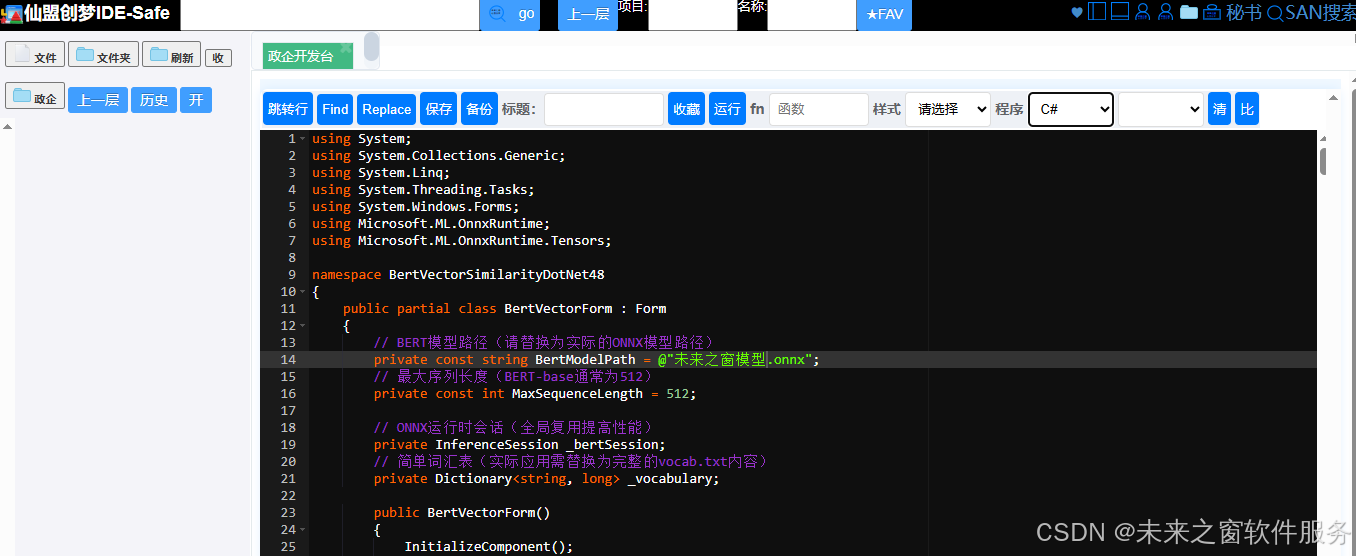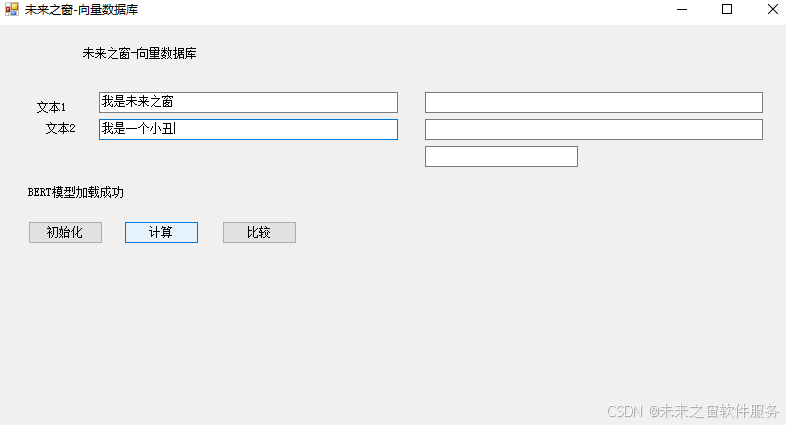
代码
using System;
using System.Collections.Generic;
using System.Linq;
using System.Threading.Tasks;
using System.Windows.Forms;
using Microsoft.ML.OnnxRuntime;
using Microsoft.ML.OnnxRuntime.Tensors;
namespace BertVectorSimilarityDotNet48
{
public partial class BertVectorForm : Form
{
// BERT模型路径(请替换为实际的ONNX模型路径)
private const string BertModelPath = @"未来之窗模型.onnx";
// 最大序列长度(BERT-base通常为512)
private const int MaxSequenceLength = 512;
// ONNX运行时会话(全局复用提高性能)
private InferenceSession _bertSession;
// 简单词汇表(实际应用需替换为完整的vocab.txt内容)
private Dictionary<string, long> _vocabulary;
public BertVectorForm()
{
InitializeComponent();
// 初始化组件
InitializeBertSession();
LoadVocabulary();
}
/// <summary>
/// 初始化ONNX会话
/// </summary>
private void InitializeBertSession()
{
try
{
var sessionOptions = new SessionOptions();
// 配置CPU执行提供者
sessionOptions.AppendExecutionProvider_CPU();
// 如需GPU加速,取消下面注释并确保安装了GPU版本的ONNX Runtime
// sessionOptions.AppendExecutionProvider_CUDA(0);
_bertSession = new InferenceSession(BertModelPath, sessionOptions);
toolStripStatusLabel1.Text = "BERT模型加载成功";
}
catch (Exception ex)
{
toolStripStatusLabel1.Text = $"模型加载失败: {ex.Message}";
MessageBox.Show($"初始化错误: {ex.Message}", "错误", MessageBoxButtons.OK, MessageBoxIcon.Error);
}
}
/// <summary>
/// 加载词汇表(简化版)
/// 实际应用中应从BERT模型的vocab.txt文件加载完整词汇表
/// </summary>
private void LoadVocabulary()
{
_vocabulary = new Dictionary<string, long>
{
{"[CLS]", 101}, {"[SEP]", 102}, {"[PAD]", 0}, {"[UNK]", 100},
{"the", 1996}, {"is", 2003}, {"a", 1037}, {"apple", 6207},
{"banana", 7827}, {"cat", 4937}, {"dog", 3899}, {"good", 2204},
{"bad", 2919}, {"hello", 7592}, {"world", 2088}, {"i", 1045},
{"you", 2017}, {"love", 2293}, {"like", 2066}, {"text", 3793}
};
}
/// <summary>
/// 计算文本向量按钮点击事件
/// </summary>
private async void button1_Click(object sender, EventArgs e)
{
if (string.IsNullOrWhiteSpace(textBox1.Text) || string.IsNullOrWhiteSpace(textBox2.Text))
{
MessageBox.Show("请输入两个文本", "提示", MessageBoxButtons.OK, MessageBoxIcon.Information);
return;
}
try
{
button1.Enabled = false;
button2.Enabled = false;
toolStripStatusLabel1.Text = "正在计算文本向量...";
// 异步计算向量,避免UI卡顿
var (vec1, vec2) = await Task.Run(() =>
{
return (
GetTextVector(textBox1.Text),
GetTextVector(textBox2.Text)
);
});
// 显示向量(仅显示前20个元素)
textBox3.Text = string.Join(", ", vec1.Take(20).Select(v => v.ToString("F4"))) + "...";
textBox4.Text = string.Join(", ", vec2.Take(20).Select(v => v.ToString("F4"))) + "...";
toolStripStatusLabel1.Text = "向量计算完成";
}
catch (Exception ex)
{
toolStripStatusLabel1.Text = $"计算失败: {ex.Message}";
MessageBox.Show($"错误: {ex.Message}", "错误", MessageBoxButtons.OK, MessageBoxIcon.Error);
}
finally
{
button1.Enabled = true;
button2.Enabled = true;
}
}
/// <summary>
/// 计算相似度按钮点击事件
/// </summary>
private async void button2_Click(object sender, EventArgs e)
{
if (string.IsNullOrWhiteSpace(textBox1.Text) || string.IsNullOrWhiteSpace(textBox2.Text))
{
MessageBox.Show("请先输入文本并计算向量", "提示", MessageBoxButtons.OK, MessageBoxIcon.Information);
return;
}
try
{
button1.Enabled = false;
button2.Enabled = false;
toolStripStatusLabel1.Text = "正在计算相似度...";
// 异步计算相似度
var similarity = await Task.Run(() =>
{
var vec1 = GetTextVector(textBox1.Text);
var vec2 = GetTextVector(textBox2.Text);
return CalculateCosineSimilarity(vec1, vec2);
});
// 显示相似度结果(范围0-1,越接近1越相似)
textBox5.Text = similarity.ToString("F6");
toolStripStatusLabel1.Text = "相似度计算完成";
}
catch (Exception ex)
{
toolStripStatusLabel1.Text = $"计算失败: {ex.Message}";
MessageBox.Show($"错误: {ex.Message}", "错误", MessageBoxButtons.OK, MessageBoxIcon.Error);
}
finally
{
button1.Enabled = true;
button2.Enabled = true;
}
}
/// <summary>
/// 将文本转换为BERT向量
/// </summary>
private float[] GetTextVector(string text)
{
if (string.IsNullOrWhiteSpace(text))
throw new ArgumentException("文本不能为空");
// 1. 文本预处理
var (inputIds, attentionMask, tokenTypeIds) = PreprocessText(text);
// 2. 准备输入张量
var inputs = new List<NamedOnnxValue>
{
NamedOnnxValue.CreateFromTensor(
"input_ids",
new DenseTensor<long>(inputIds, new[] { 1, inputIds.Length })
),
NamedOnnxValue.CreateFromTensor(
"attention_mask",
new DenseTensor<long>(attentionMask, new[] { 1, attentionMask.Length })
),
NamedOnnxValue.CreateFromTensor(
"token_type_ids",
new DenseTensor<long>(tokenTypeIds, new[] { 1, tokenTypeIds.Length })
)
};
// 3. 执行推理
using (var outputs = _bertSession.Run(inputs))
{
// 4. 提取最后一层隐藏状态并返回[CLS]标记的向量
var lastHiddenState = outputs.First(o => o.Name == "last_hidden_state").AsTensor<float>();
// 转换为一维数组(取第一个样本的第一个标记[CLS]的向量)
return Enumerable.Range(0, lastHiddenState.Dimensions[2])
.Select(i => lastHiddenState[0, 0, i])
.ToArray();
}
}
/// <summary>
/// 文本预处理:分词并转换为模型所需的输入格式
/// </summary>
private (long[] inputIds, long[] attentionMask, long[] tokenTypeIds) PreprocessText(string text)
{
// 1. 简单分词(实际应用中应使用BERT分词器的精确逻辑)
var tokens = text.ToLower()
.Split(new[] { ' ', '.', ',', '!', '?', ';', ':', '(', ')' },
StringSplitOptions.RemoveEmptyEntries);
// 2. 转换为ID,未知词使用[UNK]
var inputIds = new List<long> { _vocabulary["[CLS]"] }; // 起始标记
foreach (var token in tokens)
{
if (inputIds.Count >= MaxSequenceLength - 1) // 预留[SEP]位置
break;
inputIds.Add(_vocabulary.ContainsKey(token) ? _vocabulary[token] : _vocabulary["[UNK]"]);
}
inputIds.Add(_vocabulary["[SEP]"]); // 结束标记
// 3. 填充到最大长度
while (inputIds.Count < MaxSequenceLength)
{
inputIds.Add(_vocabulary["[PAD]"]);
}
// 4. 创建注意力掩码(1表示有效token,0表示填充)
var attentionMask = inputIds.Select(id => id != _vocabulary["[PAD]"] ? 1L : 0L).ToArray();
// 5. 创建段落ID(单句都为0)
var tokenTypeIds = new long[MaxSequenceLength];
return (inputIds.ToArray(), attentionMask, tokenTypeIds);
}
/// <summary>
/// 计算两个向量的余弦相似度
/// </summary>
private double CalculateCosineSimilarity(float[] vector1, float[] vector2)
{
if (vector1 == null || vector2 == null || vector1.Length != vector2.Length)
throw new ArgumentException("向量必须不为空且长度相同");
double dotProduct = 0;
double magnitude1 = 0;
double magnitude2 = 0;
for (int i = 0; i < vector1.Length; i++)
{
dotProduct += vector1[i] * vector2[i];
magnitude1 += vector1[i] * vector1[i];
magnitude2 += vector2[i] * vector2[i];
}
// 防止除零错误
if (magnitude1 == 0 || magnitude2 == 0)
return 0;
// 计算余弦相似度
return dotProduct / (Math.Sqrt(magnitude1) * Math.Sqrt(magnitude2));
}
/// <summary>
/// 窗体关闭时释放资源
/// </summary>
protected override void OnFormClosing(FormClosingEventArgs e)
{
base.OnFormClosing(e);
_bertSession?.Dispose();
}
#region 窗体设计器生成的代码
private System.ComponentModel.IContainer components = null;
protected override void Dispose(bool disposing)
{
if (disposing && (components != null))
{
components.Dispose();
}
base.Dispose(disposing);
}
private void InitializeComponent()
{
this.textBox1 = new System.Windows.Forms.TextBox();
this.textBox2 = new System.Windows.Forms.TextBox();
this.textBox3 = new System.Windows.Forms.TextBox();
this.textBox4 = new System.Windows.Forms.TextBox();
this.textBox5 = new System.Windows.Forms.TextBox();
this.button1 = new System.Windows.Forms.Button();
this.button2 = new System.Windows.Forms.Button();
this.label1 = new System.Windows.Forms.Label();
this.label2 = new System.Windows.Forms.Label();
this.label3 = new System.Windows.Forms.Label();
this.label4 = new System.Windows.Forms.Label();
this.label5 = new System.Windows.Forms.Label();
this.statusStrip1 = new System.Windows.Forms.StatusStrip();
this.toolStripStatusLabel1 = new System.Windows.Forms.ToolStripStatusLabel();
this.statusStrip1.SuspendLayout();
this.SuspendLayout();
// textBox1
this.textBox1.Location = new System.Drawing.Point(12, 35);
this.textBox1.Multiline = true;
this.textBox1.Name = "textBox1";
this.textBox1.Size = new System.Drawing.Size(776, 66);
this.textBox1.TabIndex = 0;
// textBox2
this.textBox2.Location = new System.Drawing.Point(12, 146);
this.textBox2.Multiline = true;
this.textBox2.Name = "textBox2";
this.textBox2.Size = new System.Drawing.Size(776, 66);
this.textBox2.TabIndex = 1;
// textBox3
this.textBox3.Location = new System.Drawing.Point(12, 257);
this.textBox3.Multiline = true;
this.textBox3.Name = "textBox3";
this.textBox3.ReadOnly = true;
this.textBox3.ScrollBars = System.Windows.Forms.ScrollBars.Vertical;
this.textBox3.Size = new System.Drawing.Size(776, 81);
this.textBox3.TabIndex = 2;
// textBox4
this.textBox4.Location = new System.Drawing.Point(12, 382);
this.textBox4.Multiline = true;
this.textBox4.Name = "textBox4";
this.textBox4.ReadOnly = true;
this.textBox4.ScrollBars = System.Windows.Forms.ScrollBars.Vertical;
this.textBox4.Size = new System.Drawing.Size(776, 81);
this.textBox4.TabIndex = 3;
// textBox5
this.textBox5.Location = new System.Drawing.Point(12, 511);
this.textBox5.Name = "textBox5";
this.textBox5.ReadOnly = true;
this.textBox5.Size = new System.Drawing.Size(200, 22);
this.textBox5.TabIndex = 4;
// button1
this.button1.Location = new System.Drawing.Point(613, 228);
this.button1.Name = "button1";
this.button1.Size = new System.Drawing.Size(175, 23);
this.button1.TabIndex = 5;
this.button1.Text = "计算文本向量";
this.button1.UseVisualStyleBackColor = true;
this.button1.Click += new System.EventHandler(this.button1_Click);
// button2
this.button2.Location = new System.Drawing.Point(234, 510);
this.button2.Name = "button2";
this.button2.Size = new System.Drawing.Size(175, 23);
this.button2.TabIndex = 6;
this.button2.Text = "计算向量相似度";
this.button2.UseVisualStyleBackColor = true;
this.button2.Click += new System.EventHandler(this.button2_Click);
// label1
this.label1.AutoSize = true;
this.label1.Location = new System.Drawing.Point(12, 15);
this.label1.Name = "label1";
this.label1.Size = new System.Drawing.Size(67, 16);
this.label1.TabIndex = 7;
this.label1.Text = "文本1:";
// label2
this.label2.AutoSize = true;
this.label2.Location = new System.Drawing.Point(12, 126);
this.label2.Name = "label2";
this.label2.Size = new System.Drawing.Size(67, 16);
this.label2.TabIndex = 8;
this.label2.Text = "文本2:";
// label3
this.label3.AutoSize = true;
this.label3.Location = new System.Drawing.Point(12, 237);
this.label3.Name = "label3";
this.label3.Size = new System.Drawing.Size(79, 16);
this.label3.TabIndex = 9;
this.label3.Text = "文本1向量:";
// label4
this.label4.AutoSize = true;
this.label4.Location = new System.Drawing.Point(12, 362);
this.label4.Name = "label4";
this.label4.Size = new System.Drawing.Size(79, 16);
this.label4.TabIndex = 10;
this.label4.Text = "文本2向量:";
// label5
this.label5.AutoSize = true;
this.label5.Location = new System.Drawing.Point(12, 489);
this.label5.Name = "label5";
this.label5.Size = new System.Drawing.Size(103, 16);
this.label5.TabIndex = 11;
this.label5.Text = "余弦相似度:";
// statusStrip1
this.statusStrip1.ImageScalingSize = new System.Drawing.Size(20, 20);
this.statusStrip1.Items.AddRange(new System.Windows.Forms.ToolStripItem[] {
this.toolStripStatusLabel1});
this.statusStrip1.Location = new System.Drawing.Point(0, 558);
this.statusStrip1.Name = "statusStrip1";
this.statusStrip1.Size = new System.Drawing.Size(800, 26);
this.statusStrip1.TabIndex = 12;
this.statusStrip1.Text = "statusStrip1";
// toolStripStatusLabel1
this.toolStripStatusLabel1.Name = "toolStripStatusLabel1";
this.toolStripStatusLabel1.Size = new System.Drawing.Size(143, 20);
this.toolStripStatusLabel1.Text = "准备就绪,等待操作";
// BertVectorForm
this.AutoScaleDimensions = new System.Drawing.SizeF(8F, 16F);
this.AutoScaleMode = System.Windows.Forms.AutoScaleMode.Font;
this.ClientSize = new System.Drawing.Size(800, 584);
this.Controls.Add(this.label5);
this.Controls.Add(this.label4);
this.Controls.Add(this.label3);
this.Controls.Add(this.label2);
this.Controls.Add(this.label1);
this.Controls.Add(this.button2);
this.Controls.Add(this.button1);
this.Controls.Add(this.textBox5);
this.Controls.Add(this.textBox4);
this.Controls.Add(this.textBox3);
this.Controls.Add(this.textBox2);
this.Controls.Add(this.textBox1);
this.Controls.Add(this.statusStrip1);
this.Name = "BertVectorForm";
this.Text = "BERT文本向量与相似度计算 (.NET 4.8)";
this.statusStrip1.ResumeLayout(false);
this.statusStrip1.PerformLayout();
this.ResumeLayout(false);
this.PerformLayout();
}
private System.Windows.Forms.TextBox textBox1;
private System.Windows.Forms.TextBox textBox2;
private System.Windows.Forms.TextBox textBox3;
private System.Windows.Forms.TextBox textBox4;
private System.Windows.Forms.TextBox textBox5;
private System.Windows.Forms.Button button1;
private System.Windows.Forms.Button button2;
private System.Windows.Forms.Label label1;
private System.Windows.Forms.Label label2;
private System.Windows.Forms.Label label3;
private System.Windows.Forms.Label label4;
private System.Windows.Forms.Label label5;
private System.Windows.Forms.StatusStrip statusStrip1;
private System.Windows.Forms.ToolStripStatusLabel toolStripStatusLabel1;
#endregion
}
}

BERT 文本向量与相似度计算:重塑自然语言处理的实用技术
在信息爆炸的数字时代,人类每天产生的文本数据呈指数级增长。如何让计算机真正理解这些文本的语义,实现精准的信息匹配与分析,一直是人工智能领域的核心挑战。BERT(Bidirectional Encoder Representations from Transformers)文本向量与相似度计算技术的出现,为解决这一问题提供了突破性方案。本文将深入解析这项技术的核心价值与应用场景,揭示其如何成为连接人类语言与机器理解的关键桥梁。
技术核心:让机器 “读懂” 文本的语义
BERT 文本向量与相似度计算技术的本质,是将人类的自然语言转化为机器可理解的数学向量,并通过计算向量间的相似度来衡量文本语义的关联程度。传统的文本处理方法(如关键词匹配)仅能基于表面词汇判断相关性,而 BERT 技术则实现了对文本深层语义的捕捉。
其工作原理可分为三个关键步骤:首先,通过 BERT 预训练模型将输入文本转换为高维向量(通常为 768 维或 1024 维),这个向量包含了文本的上下文信息和语义特征;其次,采用余弦相似度等算法计算两个向量的空间距离,距离越近则表示文本语义越相似;最后,将计算结果应用于具体业务场景,实现智能化的文本处理。
以 “苹果” 一词为例,传统方法无法区分 “我爱吃苹果” 与 “苹果发布了新手机” 中的不同含义,而 BERT 向量能通过上下文信息生成差异显著的向量表示,使得机器能够准确识别同一词汇在不同语境中的语义差异。这种语义理解能力的跃升,正是 BERT 技术的核心价值所在。
应用场景:从信息处理到决策支持的全链条赋能
BERT 文本向量与相似度计算技术的应用场景极为广泛,几乎覆盖所有需要处理文本信息的领域。在实际落地中,其价值主要体现在以下几个方面:
智能信息检索与推荐是该技术最成熟的应用领域之一。在搜索引擎中,传统关键词匹配常常返回大量不相关结果,而基于 BERT 向量的检索系统能理解用户查询的真实意图。例如,当用户搜索 “如何提高电脑运行速度” 时,系统不仅能匹配 “加速”“优化” 等近义词,还能识别 “电脑很卡怎么办” 这类语义相关的内容,显著提升检索精准度。电商平台则可利用该技术实现商品标题与用户 query 的深度匹配,当用户搜索 “适合送礼的笔记本” 时,系统能准确推荐 “精美包装的记事本套装” 等相关商品,而非仅局限于 “笔记本电脑” 的字面匹配。
文本内容审核与过滤领域也因这项技术实现了效率革新。社交平台每天需要处理海量用户评论,传统关键词过滤容易被谐音、变体词规避(如用 “菜虚鲲” 替代敏感词)。基于 BERT 向量的审核系统能通过语义相似度比对,将新评论与违规文本库中的向量进行比对,识别出语义相近的不良内容。在金融领域,这种技术可用于识别诈骗话术变种,当新出现的诈骗短信与已知模板语义相似时,系统能自动预警,有效提升风险防控能力。
知识管理与智能问答系统借助该技术实现了知识的高效关联。企业知识库中存储着大量文档,传统检索往往需要用户准确输入关键词。而引入 BERT 向量后,员工只需用自然语言描述问题(如 “如何申请年假”),系统就能自动匹配知识库中 “带薪休假申请流程” 等相关文档。在客服领域,智能问答机器人可通过计算用户提问与标准问题库的向量相似度,快速定位最佳答案,同时具备处理模糊查询的能力,例如将 “订单好几天没到” 与 “物流延迟处理” 相关联,提升客户满意度。
学术与科研领域则利用该技术加速文献分析与发现。研究人员输入一篇论文摘要后,系统能自动推荐语义相似的相关研究,帮助发现跨领域的潜在关联。在专利分析中,通过比对新申请专利与现有专利的文本向量,可快速判断创新性与相似度,辅助专利审查决策。
技术优势:超越传统方法的四大突破
相较于传统的文本处理技术,BERT 向量与相似度计算具有不可替代的优势:
语义理解的深度是其最显著的特点。传统方法基于词袋模型或 TF-IDF 等统计方法,无法捕捉词语在不同语境中的含义变化,而 BERT 通过双向 Transformer 结构,能充分理解上下文信息,实现真正的语义级匹配。这种能力使得 “银行存款” 与 “在银行存钱” 这类表述能被正确识别为语义相似,而传统方法可能因词汇顺序不同而误判。
跨领域适应性强是另一重要优势。BERT 模型通过大规模通用语料预训练后,只需少量领域数据微调,就能在特定领域(如医疗、法律)表现优异。在医疗领域,它能理解 “心梗” 与 “急性心肌梗死” 的同义关系;在法律领域,可准确识别 “合同纠纷” 与 “契约争议” 的语义关联,大幅降低不同专业领域的应用门槛。
处理效率与准确性的平衡使其具备实用价值。虽然 BERT 模型的计算成本高于传统方法,但通过模型蒸馏、量化压缩等优化技术,已能满足实时处理需求。在实际应用中,单次文本向量计算可在毫秒级完成,完全适配 Web 服务、移动应用等场景的响应要求。
对长尾需求的支持能力显著提升系统鲁棒性。传统关键词匹配对低频表达和新出现的词汇处理效果差,而 BERT 向量能通过语义联想理解新兴词汇和表达方式。例如在网络流行语处理中,能识别 “yyds” 与 “非常出色” 的语义关联,确保系统对语言演变的适应性。
未来展望:从单一功能到智能生态的演进
随着技术的不断成熟,BERT 文本向量与相似度计算正从单一功能模块向构建完整智能生态演进。在多模态融合方向,该技术将与图像、语音向量技术结合,实现 “文本 - 图像”“语音 - 文本” 的跨模态相似度计算,例如通过文本描述匹配相似图片,或通过语音转写文本与知识库内容比对。
在个性化服务领域,基于用户历史行为文本的向量分析,能构建更精准的用户画像,实现 “千人千面” 的智能推荐。教育领域可通过分析学生提问文本与教学内容的相似度,推送个性化学习资料;职场中则能根据员工的工作文档向量,智能推荐相关培训资源。
技术优化方面,轻量级 BERT 模型(如 DistilBERT、ALBERT)的发展将进一步降低部署成本,使其能在移动设备、嵌入式系统等资源受限环境中应用。边缘计算场景中,终端设备可本地完成文本向量计算,提升隐私保护水平与响应速度。
BERT 文本向量与相似度计算技术,正以其强大的语义理解能力,重塑人机交互的方式,推动信息处理从 “机器匹配” 向 “机器理解” 跨越。在这个信息过载的时代,这项技术不仅是提升效率的工具,更是帮助人类从海量文本中挖掘价值、发现关联的智能助手,其应用前景将随着人工智能技术的发展而不断拓展。
阿雪技术观
在科技发展浪潮中,我们不妨积极投身技术共享。不满足于做受益者,更要主动担当贡献者。无论是分享代码、撰写技术博客,还是参与开源项目维护改进,每一个微小举动都可能蕴含推动技术进步的巨大能量。东方仙盟是汇聚力量的天地,我们携手在此探索硅基生命,为科技进步添砖加瓦。
Hey folks, in this wild tech - driven world, why not dive headfirst into the whole tech - sharing scene? Don't just be the one reaping all the benefits; step up and be a contributor too. Whether you're tossing out your code snippets, hammering out some tech blogs, or getting your hands dirty with maintaining and sprucing up open - source projects, every little thing you do might just end up being a massive force that pushes tech forward. And guess what? The Eastern FairyAlliance is this awesome place where we all come together. We're gonna team up and explore the whole silicon - based life thing, and in the process, we'll be fueling the growth of technology.